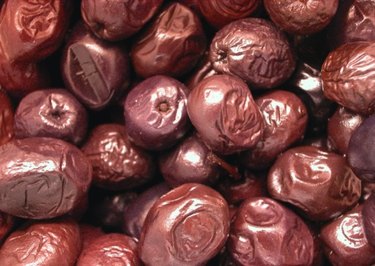
Much like the stone of an avocado, olive pits require a little assistance to grow into trees. The shell is tough and conditions in the U.S. generally don't suit olive germination and growth. However, growing an olive from the pit is possible. But, planting your pit isn't the most effective way to produce trees bulging with juicy olive fruit.
Propagation
Video of the Day
Commercial olive growers rarely grow their trees directly from olive pits. Growing in this manner doesn't guarantee trees with the same fruit characteristics as the parent tree. In many cases, the tree produces smaller fruit, similar to wild olives. Olive growers tend to use grafting or cuttings to propagate new plants. This creates a plant that produces similar fruit to the grafted species. Pits take between one and six months to germinate, with some species' germination rates no more than 5 percent, according to the "Olive Production Manual" by G. Steven Sibbett and Louise Ferguson.
Video of the Day
Technique
Olive pits are extremely hard -- as you know if you've bitten into a stray olive stone. This makes germination difficult. Gardeners usually give olive pits a helping hand by either soaking them in sulfuric acid for a day or by cracking the external shell with a hammer. In the case of acid bathing, the seed must be rinsed in fresh water before planting to get rid of all the corrosive liquid. Both of these methods help with scarification -- a process of damaging the seed to aid germination.
Climate Requirements
Olive trees grow when temperatures reach and stay above 70 degrees Fahrenheit. Under that temperature, olives stay in the dormant phase. When temperatures warm up, the seed germinates and starts to grow. However, a late frost can interfere with growth and limit fruiting. Olives also require mild winter temperatures. Anything below 17 degrees causes tree damage, while conditions lower than 10 degrees usually kill the plant or prevent growth entirely that year.
Considerations
Though very vulnerable to low temperatures, olive trees tolerate lots of different soil conditions, including relatively shallow soil beds. Planting a prepared olive pit in soil with a pH between 5.5 and 8.5 will likely produce a tree in the right climate. Soil texture can range from sticky clay to light sand, though well-draining soil works best. The tree grows at a slow pace. It could be over five years before you have a sizable olive tree grown from your pit.